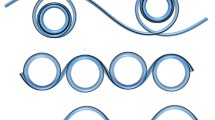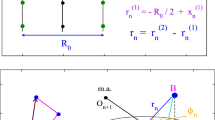Summary
In long molecules with helical structure it is shown that the electron’s response functionF(q,T) is singular for various wave vectors. Then deformed phases associated with different periodicites can occur as a function of external pressure. The calculation was done as a function of temperature and for small number of atoms per turn.
Riassunto
Si mostra in lunghe molecole con struttura elicoidale che la funzione di risposta dell’elettroneF(q, T) è singolare per vari vettori d’onda. Allora possono verificarsi fasi deformate associate a diverse periodicità in funzione della pressione esterna. Si effettua il calcolo in funzione della temperatura e per un numero ridotto di atomi per spira.
Резюме
В длинных молекулах с геликоидальной структурой показывается, что функция электронного откликаF(q, T) является сингулярной для различных волновых векторов. В связи с этим могут возникать деформированные фазы, связанные с различными периодичностями, в зависимости от внешнего давления. Проводятся вычисления в зависимости от температуры и для малого числа атомов на виток.
Similar content being viewed by others
References
Highly Conducting One Dimensional Solids, edited byJ. T. Devreese, R. P. Evrard andV. E. van Doren (Plenum Press, New York, N.Y., 1979).
The Physics and Chemistry of Low Dimensional Solids, edited byL. Alcacer (D. Reidel, Dordrecht, 1980).
Electronic Properties of Inorganic Quasi-One-Dimensional Compounds, Part I, edited byP. Monceau (D. Reidel Dordrecht, 1985).
Superconductivity in Magnetic and Exotic Materials, edited byE. T. Metsubara andA. Kotani (Springer-Verlag, 1984).
M. J. Rice andS. Strasser:Solid State Commun.,13, 125 (1973).
E. Marsch, W.-H. Steeb andD. Grensing:J. Phys. F,7, 401 (1977).
S. Kivelson andD. Heim:Phys. Rev. B,26, 4278 (1982).
J. M. Ziman:Principles of the Theory of Solids (Cambridge University Press, 1972).
A. J. Heeger:Highly conducting one dimensional solid, edited byJ. T. Devreese, R. P. Evrard andV. E. van Doren (Plenum Press, New York, N.Y., 1979).
J. S. Smart:Effective Field Theories of Magnetism (W. B. Saunders Company, 1966).
H. Dreyssé, D. Tomanek andK. H. Bennemann:Surf. Sci.,173, 538 (1986).
F. S. Bates andG. L. Baker:Micromolecules,16, 1013 (1983).
M. L. Elert andC. T. White:Phys. Rev. B,28, 7387 (1983).
B. K. Rao, J. A. Darsey andN. R. Kestner:Phys. Rev. B 31, 1187 (1985).
Author information
Authors and Affiliations
Rights and permissions
About this article
Cite this article
Gottlieb, D., Melo, F. Peierls transition in helical structures. Il Nuovo Cimento D 10, 1427–1437 (1988). https://doi.org/10.1007/BF02454209
Received:
Issue Date:
DOI: https://doi.org/10.1007/BF02454209




